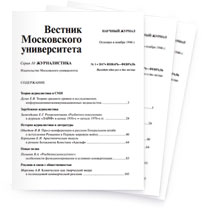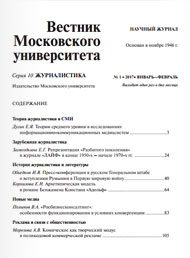Issue
№ 2
' 2022
Content:
-
Media Economics
«Financial Transparency of Large Media Businesses in Russia: Changes in the Aspects of the Problem»
This paper examines the legislative norms on forming and revealing financial accountability for different types of media enterprises in modern Russia. The author analyzed the difficulties related to the differences among the existing legal approaches to the formats of information provision. The documents the analysis was based on were as follows: the Tax Code of RF (1998), the laws "On the Stock Market" (1996), "On the Official Statistical Records and the System of State Statistics in the Russian Federation" (2007), "On Consolidated Financial Statements" (2010) and "On Accounting" (2011). The current versions of the texts were borrowed from the information and reference system KonsultantPlus. While investigating a number of industry cases, some gaps were found that prevented systematic collection and study of economic indicators of certain players in the media market. The sample included six largest media enterprises of the country (Yandex, Mail.Ru, Google, Gazprom-Media, National Media Group and VGTRK) as well as six leaders of the industry's individual segments. The websites of the companies, the Rosstat base and the Internet resource of the Federal Tax Service were used as a source of financial information. The author of the paper concluded that the main problem today is the absence of a mandatory requirement of consolidated financial accountability for all media companies that appear to be holding corporations. This, in particular, makes it imposible to correctly calculate the volumes of the national media industry in general and its individual segments.
Keywords: media holding, legal entity, accountability, indicator, transparency, legislation, requirements
DOI: 10.30547/vestnik.journ.2.2022.320Sergey S. Smirnov 3 -
History of Journalism
«Worker-Peasant Correspondents and Their Tasks in the 1920s. The Experience of the Rabotnitsa and Krestyanka Magazines»
The purpose of this article is to consider the tasks of the worker-peasant correspondent movement, which developed in the USSR in the 1920s. The historical conditions of the establishment of the press by the Bolshevik Party are examined. Its peculiarity consists in the fact that in the 1920s the audience of the Soviet press was almost illiterate. Despite this, great efforts were made to attract workers and peasants to work in the press as assistants. The analysis of the documents of the Bolshevik Party (including the interview of I.V. Stalin in 1924) made it possible to identify the tasks that were set before the worker-peasant correspondent movement. The study is based on the examination of the experience of the well-known women's magazines Rabotnitsa and Krestyanka, which actively created a network of their readers in the 1920s, who acted as non-professional journalists. As a result, the author of the article was able to collect data on how the editorial boards of these magazines trained non-professional journalists, what methods were used to attract them to work, what difficulties were overcome. The study made it possible to formulate some conclusions. Part of the tasks of the worker-peasant correspondent movement relates to the performance of the Soviet system of agitation and propaganda, created in the 1920s. This movement helped to create channels of communication between authorities and representatives of the people, it simultaneously formed and expressed public opinion. Part of the tasks of the movement relates to the operation of Bolshevik and Soviet newspapers and magazines. For example, it helps to evaluate the effectiveness and relevance of press publications.
Keywords: history of the Soviet press, worker-peasant correspondents, women's magazines
DOI: 10.30547/vestnik.journ.2.2022.2149Olga D. Minaeva 21 -
«The Religious and Philosophical Category of Virtue in the Metatext of the Trudoliubivaya Pchela Journal (1759) Published by A. P. Sumarokov»
The first private monthly journal Trudoliubivaya Pchela, published by A. P. Sumarokov in 1759, became a communicative platform for the authors of the publication and an opportunity to express their socio-political as well as religious and philosophical views. This article records and studies the cases of reference to the category of virtue in the monthly books of Sumarokov's journal. The narrative potential of this universal united different-genre publications into a special metatext. On the pages of Trudoliubivaya Pchela in 8 issues out of 12, 19 works directly linked to the authors of the journal's reception of virtue were published. Most of the authors became knights of the true Enlightenment – Masons. It is no coincidence that Sumarokov’s and his sympathizers' conceptions of virtue were influenced by the so-called Anderson Constitution – a Masonic constitution written by the British Freemason D. Anderson. Drawing on the journalistic experience of J. Addison and R. Steele, the editors of Trudoliubivaya Pchela appealed specifically to virtue as an inalienable active principle of everyone and the duty of a worthy citizen. On the ground of frequency of references to the concept of virtue, the article concludes that this universal moral category in the journal’s metatext became the key narrative potential that enabled Sumarokov to turn this monthly publication into a tool of communicative influence on its readers. Most of them sooner or later became "industrious bees" – masons.
Keywords: Russian literature, history of journalism, Sumarokov, Trudoliubivaya Pchela, virtue, metatext, cyclization
DOI: 10.30547/vestnik.journ.2.2022.5067Andrey V. Rastyagaev, Julia V. Slozhenikina 50 -
«The Sentimentalist Publication Model of the 1790s in Russia»
Sentimentalism, which reached Russia at the end of the 18th century, determined the development of the literary process in the country and set the vector for the movement of Russian journalism. In search of a platform for expressing their views and creative fulfillment, sentimentalist writers and other aspiring authors began to actively publish magazines of sentimentalist orientation. Over the last decade of the 18th century, seven large magazines were published in Russia, which could be fully considered sentimentalist: Moskovskiy Zhurnal (1791–1792), Chtenie dlya Vkusa, Razuma i Chuvstvovaniy (1791–1793), Delo ot Bezdelya (1792), Ezhenedelnik (1792), Priyatnoe i Poleznoe Preprovozhdenie Vremeni (1794–1798), Muza (1796), Ippokrena, ili Utekhi Lyubosloviya (1799–1801). Moskovskiy Zhurnal published by N.M. Karamzin became a major example to follow for publishers in the 1790s; however, an analysis of the structure and content of other publications of the time showed that other editors also skillfully experimented with magazine formats. One way or another, one can claim the existence of the sentimentalist publication model, which laid the foundations for the development of journalism and, in particular, literary magazines in the 19th century.
Keywords: sentimentalism, literary magazine, 18th century, N. M. Karamzin, Moskovskiy Zhurnal, V. S. Podshivalov, magazine model
DOI: 10.30547/vestnik.journ.2.2022.6893Alexandra R. Akchurina 68 -
Modern Journalism: Subjects and Issues
«Representation of the Black Lives Matter Movement in the CPC’s Newspaper Global Times»
The study of political discourse in Chinese mass media allows us to trace how ideas important for the ruling political elite are conveyed through news reports. The purpose of our study is to contribute to the existing research and to reveal how discursive practices in the news about the Black Lives Matter (BLM) movement in the United States of America serve the goals of the Chinese political elites. From a theoretical point of view, the USA stands in as the Other, the discussion of which is important for China’s self-identification. The empirical part of the study includes a frame-analysis of 74 Chinese-language articles collected from the electronic version of Global Times, which mention the BLM movement between May and October 2020. Together and often instead of racism, discrimination and failed social policies, BLM news reports focus on human rights violations, a weakening of the vertical of power, and government dysfunction in the United States. Thus, the news about the Other in Chinese mass media is used to respond to criticism coming from the authorities and to highlight the shortcomings of the American political model and the corresponding strengths of the Chinese one.
Keywords: Сhinese mass media, foreign news, frame analysis, othering, Black Lives Matter
DOI: 10.30547/vestnik.journ.2.2022.94110Anastasiya D. Dolokhova, Elena D. Soboleva 94 -
Media Language
«Cognitive-Discursive Analysis of the Idiom “Glass Ceiling” in American Social Media»
This paper discusses the results of a cognitive-discursive study of the idiom "glass ceiling", which has retained popularity in American socio-political discourse for more than four decades. According to Merriam-Webster Dictionary, the phrase means “an intangible barrier within a hierarchy that prevents women or minorities from obtaining upper-level positions”. The author of the paper studied its linguistic and cognitive-discursive features with a special focus on its performance as a discursive “guide” for interpreting the socio-political phenomenon of gender inequality in the professional sphere. The empirical material is made up of posts, political cartoons and memes published оn social media by American women's rights activists and online communities. The author suggested a three-profile approach to the study of the phrase “glass ceiling”. The linguistic profile includes the aspects of its origin, definition as well as syntagmatic and paradigmatic relations. As can be seen from the linguistic profile, "glass ceiling" is a modern idiom that is currently being recycled in discourse in its derivative forms and creative modifications. As the “cognitive profile” of the idiom demonstrates, it encapsulates a universal metaphorical concept that makes the phrase and its derivatives efficient tools for conveying socially significant knowledge. The interplay of verbal and visual aspects observed in the sampled examples is exploited by the authors of the media texts under consideration for framing the issue of gender inequality in the workplace. The following media frames have been singled out: the glass ceiling is a real obstacle; the glass ceiling is created by men; the glass ceiling can be broken; breaking the glass ceiling is potentially dangerous; successful glass ceiling breakers are superheroines; the figures of H. Clinton and K. Harris are the epitomes of female success. The discursive profile unveiled the diversity of the idiom. The author of the paper can conclude that the prevalent creative use of the idiom in discourse arises from the current socio-political environment and reflects the necessity to name the significant changes taking place in the USA.
Keywords: gender inequality, idiom “glass ceiling”, creolized texts, feminist movement, social media, media framing
DOI: 10.30547/vestnik.journ.2.2022.111135Anna A. Konstantinova 111







